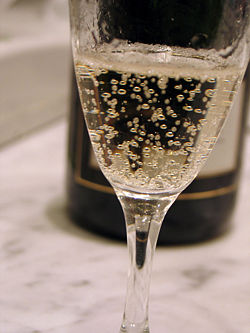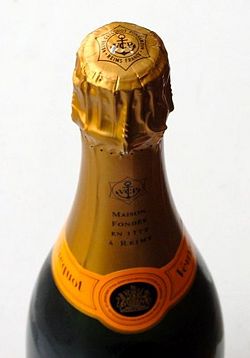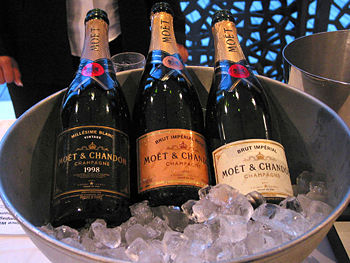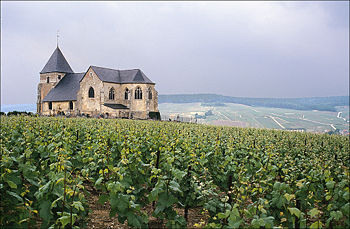Champagne: Difference between revisions
imported>Meg Taylor m (grammar: 11am -> 11 a.m.) |
imported>Meg Taylor (copyedit) |
||
| Line 140: | Line 140: | ||
==References== | ==References== | ||
{{reflist}} | |||
Revision as of 19:38, 19 February 2010
Champagne is a sparkling wine produced in the French region of the same name. Because of its perceived scarcity and expense, its name has come to denote luxury, festivities, celebrations, and well-being. While other quite similar wines are produced throughout the world, such as Asti Spumante in Italy, they cannot legally be called "Champagne" because they are not produced in this single region of northern France. The European Union has officially given Champagne "protected designation of origin" status (PDO), which restricts the use of its name within Europe. The word is always spelt with a capital C in American English, but in British English, as in French, the wine is "champagne"; it is frequently called "champers" in England and "bubbly" in the United States.
Champagne is typically made as a white wine, but pink champagne known as rosé can also be made, usually by adding some red wine, of the same region, at the blending stage. The bubbles are formed by the yeast, which makes carbon dioxide as a by-product of the fermentation. If stored in wooden barrels, the gas naturally escapes. However, Champagne is bottled before the fermentation process has completely used all the sugar in the wine (taking advantage of a slowing of fermentation during the cold winter months to perform the bottling). The second stage of fermentation occurs inside the bottle, which does not allow the gas to escape, creating a sparkling wine. The pressures caused by the production of the gas means that the wine must be stored in specially designed, high strength bottles. These distinctively shaped bottles are stoppered with over-sized corks, allowing the bottle to be opened by hand without use of a cork screw. A wire cage is placed over the cork and tightened to the bottle neck to secure the cork. The top of the bottle is then usually covered with foil.
Vintage and Brut
The vast majority of Champagne wines are blended. When bottling, wines from different grape varieties, wine growers and years are mixed together. This produces a more consistent product both in appearance and taste, from year to year. The art of blending is highly specialised and great care is taken over the process.
Occasionally, in the event of a especially good harvest, a producer might create a Vintage. This means that all the wines used in the blend are of the same years grape crop. Vintage Champagnes usually have a distinctive character of their own that marks them apart form other wines. A vintage bottle will be marked with the date on the bottle. Whether a wine is vintage or non-vintage, only the best and most distinctive wines acquire the label Special Cuvées. This mark shows the producer is particularly proud of this wine.
Peoples' tastes in wine have changed over the years. Also there are trends form one country to another. Some people prefer a sweeter wine and others prefer dry. Champagne may be dosed with sugar to help control fermentation and regulate the desired sweetness. The resulting sweetness of the wine is marked on the label. Wines with more than 50 grams of sugar per litre are labelled Sweet. A Demi-Sec refers to wine with 33 to 50 grams of sugar per litre. If the wine contains 17 to 35 grams per litre then it is labelled Sec. Between 12 and 20 grams per litre is Extra dry. Anything less than 15 grams of sugar per litre of wine is labelled Brut. The label Extra brut refers to sugar contents of less than 6 grams per litre and Brut Nature, Pas Dosé or Dosage Zero will have less than 3 grams of sugar for each litre of wine.
Uncorking, serving and drinking champagne
Although popular culture celebrates the loud popping sound which can accompany the opening of a bottle of champagne, some care is required when opening a bottle of champagne, as the high pressure within the bottle can cause the cork to fly out at high speed. Deaths have been recorded as a result of such free flying corks and eye injuries are not infrequent. The correct way to open a bottle is to remove the wire cage first. Then, with the top of the cork firmly grasped in the palm of your hand and the bottle pointing well away form anyone, twist the cork within the bottle neck. The pressure inside the bottle will push the now loosened cork out and your firm grip will prevent the cork becoming a dangerous projectile bouncing off the walls and ceiling. Care should be taken not to shake the bottle prior to opening. If a bottle is accidentally shaken, it should be left to settle for some time before uncorking. If a foam spray is desired, this can be achieved by shaking the bottle after it has been uncorked, not before. Popping and foaming are considered déclassé at formal occasions. This method is the most traditional.
Alternatively, there is a method known as sabering[1], in which a sabre is used to cleanly "slice" off the top of the champagne bottle. The force produced by the champagne upon its opening is exerted in such a way that the cork, glass ring, and any fragments or shards of glass that result are blown clean away at approximately 100 psi. Sabrage should not be attempted unless one is an expert.[2] There are several caveats that must be taken into consideration: The bottle type, some bottles of champagne do not sabrate as well as others (the density and thickness of the glass is critical); and the type of seal, a screw-top or rubber cork may result in bottle integrity failure.
Champagne should always be served chilled. A partly consumed bottle is usually kept chilled by placing it in a bucket of iced water. The traditional glass for champagne was a flute, a tall narrow glass with a long stem. This glass is still popular with many drinkers and is generally recommended by most wine connoisseurs.[3] During the 19th Century, a wide dish or saucer shaped glass called a coupe, sometimes miss pronounced as cup, became popular. This glass is the style used when making a Champagne fountain. Many people now prefer to use a regular tulip shaped wine glass. This glass allows a better nose when tasting, so giving more flavour to the wine.
One of the more spectacular ways of serving is the Champagne fountain. The glasses are arranged in rings stacked one atop the other to create a wedding cake like structure. The Champagne is poured into the top most glass. This glass is allowed to overflow into the ring of glasses blow which in turn will overflow into the next tier and so on until the bottle is exhausted.
After use, Champagne glasses should not be cleaned with soap.[4] Instead they should be rinsed and wiped clean then allowed to drip dry. An overly clean glass will not allow for the formation of the bubbles and so reduce the sparkle of the wine. The bubbles in the wine require a nucleation site on which to form. It used to be thought that slight deformations in the glass itself formed the basis of the nucleation sites. However, studies have shown these to be too small to allow for the bubble formation. The bubbles actually nucleate on dust and dirt particles left over from cleaning or from airborne deposits. It is recommended, if bubbles are desired, that the glass should be wiped with a dry cloth just before use. This will deposit some cloth fibers onto the glass which can then act as nucleation sites.[5]
History of champagne
Wine has been produced in the Champagne region of France since before there was a France. After his conversion to Christianity, Clovis, King of the Franks, was anointed with wine from the Champagne region on the Christmas night of 496. However, it was not until near the end of the 17th century that the wine got its sparkle, supposedly the invention of Dom Pierre Pérignon, a monk who was the cellar master at the Hautvillier abbey. It is frequently written that when Dom Pérignon first tasted his sparkling creation, he cried out, "Come quickly! I am drinking the stars!" Writing in a New York Times book review about the "Widow Clicquot", another famed Champagne maker, the critics write:[6]
A charming tale, but bogus.... for a decade after 1660, when Dom Pérignon gained fame as a master blender, he steadfastly worked at ways to prevent wine from developing bubbles. "In the 17th century," she reports, "winemakers were anything but delighted by the voluntary sparkle that developed in their casks come spring."
It was at this time that bottling wine came into fashion. The advanced technology required to produce the high strength bottles was an English invention. This has lead some people to suggest that it was the English, and not the French, who originally produced champagne style wines. However, this claim is disputed.
Bottles and corks
The bottle used for Champagne is distinctive. Its size, weight and shape make it easily identifiable. This adds to the Champagne branding. The bottle is made of thicker glass than a regular wine bottle. Its shoulders curve gently giving a long elegant neck. The base of the bottle has a particularly large indentation, known as a punt. At the neck of the bottle near the cork, the glass widens to form a lip round which the wire cage can be secured. These features are required in order that the bottle can withstand the high pressures created during fermentation.
Even with these design considerations, breakages during fermentation are not uncommon. Often the disturbance of one bottle failing can set of it's neighbours in a chain reaction. In the past 20% losses were common and sometimes the loss to breakage could be as high as 90%. The breaking bottles could make the wine cellars dangerous. Workers in the wine cellars during spring, when the second fermentation occurs, would wear a metal mask similar to those used by baseball players. These days, improved quality control has reduced breakage to around 5%.
| Name | Capacity | Bottles |
|---|---|---|
| Quarter (Split) | 18.75 cl | 1/4 |
| Half bottle | 37.5 cl | 1/2 |
| Bottle | 75 cl | 1 |
| Magnum | 1.5 litres | 2 |
| Jeroboam | 3 litres | 4 |
| Rehoboam | 4.5 litres | 6 |
| Methuselah | 6 litres | 8 |
| Salmanazar | 9 litres | 12 |
| Balthazar | 12 litres | 16 |
| Nebuchadnezzar | 15 litres | 20 |
| Salomon (Solomon) | 18 litres | 24 |
| Primat | 27 litres | 36 |
Champagne bottles come in a variety of sizes, each with its own name. The names of the larger sizes are taken form names in the Bible. The most common size is the 75 cl Bottle. The 150 cl Magnum is considered by some to be to optimum size since is contains the lowest air to wine ratio, there is less chance of oxidation of the wine. Larger and smaller sizes are less common but are produced. Large bottle are difficult to handle during riddling and disgorgement. As a result, most producers will make large bottles by fermenting in Magnums then decanting several bottles into the larger. This can result in a loss of carbonation and so the large bottles are not considered high quality. However, the House of Drappier does ferment the wine in the larger bottle sizes. It's not unknown for injuries to occur while disgorging the largest bottles. Small bottles are also produced in 18.75 cl and 37.5 cl sizes. A one pint (60 cl) bottle was created for Winston Churchill, which his servant brought him at 11 a.m. every morning.
Production
There are several factors that go to make Champagne special. The soil and climate of the region, referred to as the XXX is important. Champagne region represents the Northern boundary for the production of the gape vines used. The vines are very susceptible to late frosts. However, it is the slow development that the colder weather brings that helps make the grapes just right for Champagne production. Also the chalky soil and the position of the vineyards on hillsides tends for excellent irrigation and bountiful sunlight.
There are three varieties of grape used for producing Champagne: Pinot noir, Pinot meunier and Chardonnay. Each variety brings distinctive characteristics to the finished product. From flowering to harvest takes approximately 100 days. Harvesting is done by hand. Only the best quality grapes are selected and gathered carefully so as not to damage the fruit.
The grapes are crushed within a few hours of harvest. Care must be taken not to crush too soon as the grape skins would then colour the juice. The process of crushing is carefully monitored and regulated to control flavour and appearance: 160kg of grapes produces 102 litres of must. This means that the average bottle of champagne requires one whole vine's grape harvest to produce it.[7]
The must is placed into vats or barrels for fermentation. Traditionally wooden vats were used, and still are by many producers who claim it gives a rounder flavour to the wine. Many vineyards have switched to using stainless steel vats which allow for a more consistent product. After the first fermentation comes the blending. Several wines form different vineyards and even different years harvest are used to blend the Champagne. A great deal of skill is required. The blender seeks not only to make a excellent tasting wine, but also one that is consistent with the tradition of their brand. It may take as few as 3 wine or as many as 50 to achieve the perfect blend.
After blending, the wine is bottled. Normal, non sparkling, wines will have completed it's fermentation and used up all it's sugar content prior to bottling. In the case of sweet wines, the yeast is killed to prevent fermentation from continuing. If the fermentation was allow to continue inside a normal glass bottle, the pressures would break the glass. However, the champagne bottle is specially designed to withstand the high pressures. During the cold of winter, at the end of the first fermentation, the blended wine is transferred to bottles. There is still some sugar remaining so the fermentation continues when the weather warms again in spring. The carbon dioxide gas that forms the bubbles is a byproduct of the fermentation process. Since the wine is now inside the sealed bottle, the gas cannot escape and the pressure causes the gas to dissolve into the wine.
Wines are aged inside the bottle. The minimum aging required by the Comité Interprofessionnel du vin de Champagne is fifteen months for non vintage and three years for vintage Champagnes. It is not uncommon for longer aging periods. Sometimes aging lasts for decades.
The final stages in the process are the remuage and disgorgement. The purpose of this is to remove the sediments that have formed in the wine bottle during fermentation and aging. The wines, which have been aged with the bottle held horizontally, are gradually rotated and tilted into the vertical. Traditionally this was done by hand, each bottle was given a quarter turn then the rack tilted slightly, another quarter turn each then another tilt. This process has now been automated by mechanised racks that turn the bottles and tilt at exactly the right rate. This process of turning and tilting draws the sediments into the neck of the bottle.
Disgorgement involves removing the temporary cap used for aging, the pressure inside the bottle pushes out the unwanted sediments. This used to be done by hand but like the remuage, the process has now been mechanised. In the modern disgorgement process, the neck of the bottle is immersed vertically in bath at -25°C. The sediments freeze into a plug in the neck. This plug is pushed out by the gas pressure inside the bottle when the bottle's cap is removed.
Finally the wine bottle is topped up to full using some more champagne and if required, some cane sugar. This is known as the liqueur de dosage. The dosage gives the wine maker one last chance to alter the flavour of the wine. The disgorged wine is then finally corked, the metal cage attached and foil wrapper and labelling put on.
References
- ↑ Champagne Sabering. champagnesabering.com (2004). Retrieved on 2007-09-05.
- ↑ http://www.champagnesabering.com/index.php?id=4
- ↑ "Serving Sparkling Wine, Though tradition once dictated the flat, round coupe being the Champagne glass of choice, it's now widely accepted that the tall, tapered flute best displays the wine's bubbly nature. The narrow opening at the top helps reduce exposed surface area and better holds in the wine's mousse and keeps it fizzy." San Francisco Chronicle, "The Bubbly Issue," Wine Section, November 30, 2007, page F7
- ↑ Champagne : Effervescence : Summery (html). The Comité Interprofessionnel du vin de Champagne. Retrieved on September 5, 2007.
- ↑ Liger-Belair, Gérard; Philippe Jeandet, Laboratoire d'œnologie, faculté des sciences de Reims, France (2002). "Effervescence in a glass of champagne: A bubble story". Europhysics News Vol. 33 (No. 1). Retrieved on September 7, 2007. [e]
- ↑ Jane and Michael Stern, reviewing The Widow Cliquot: The Story of a Champgagne Empire and the Woman Who Ruled It, by Tilar J. Mazzeo, Collins/HarperCollins Publishers, New York, 2009, page 5 of the New York Times Book Review of December 28, 2008, at [1]
- ↑ http://www.champagne.com




